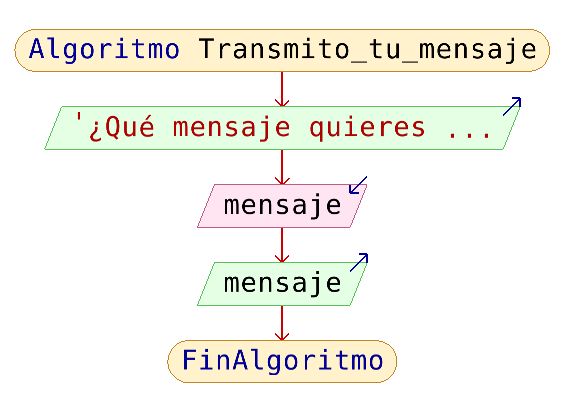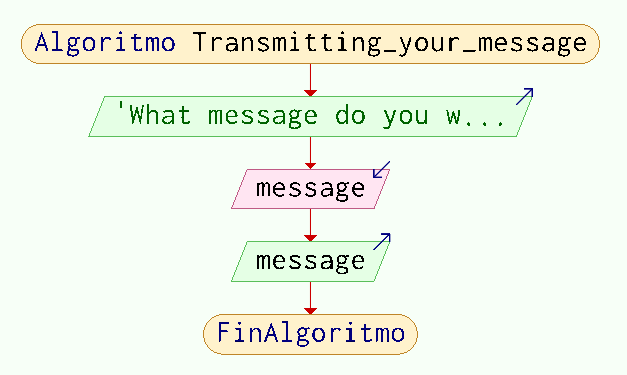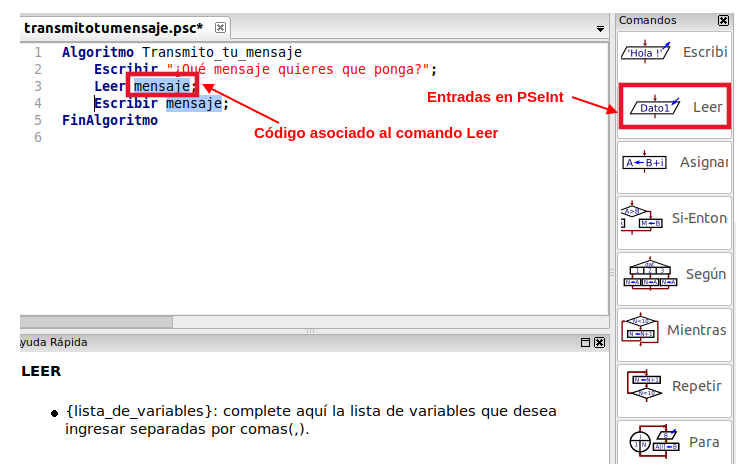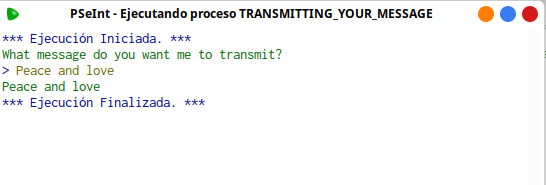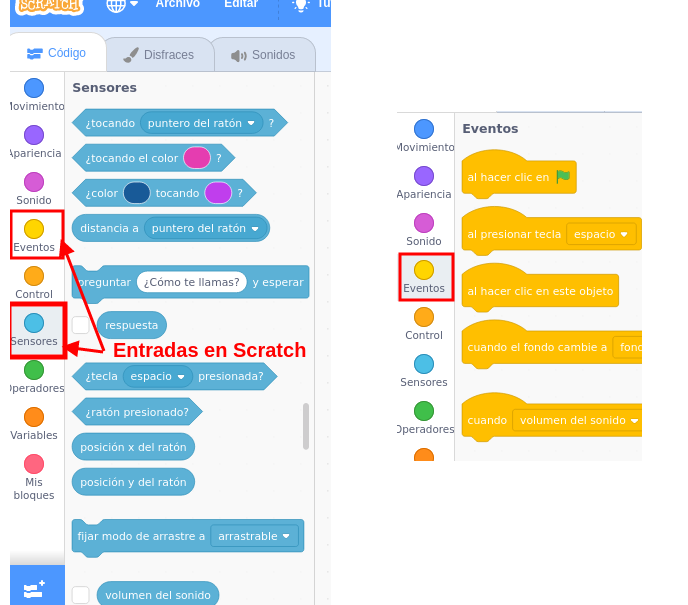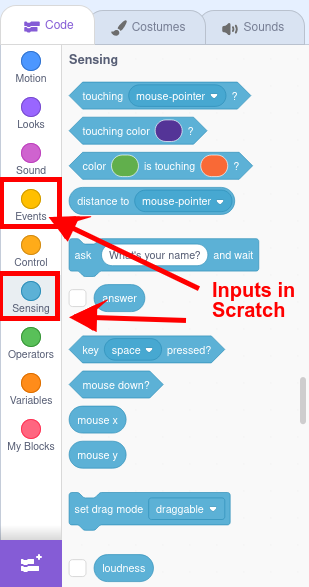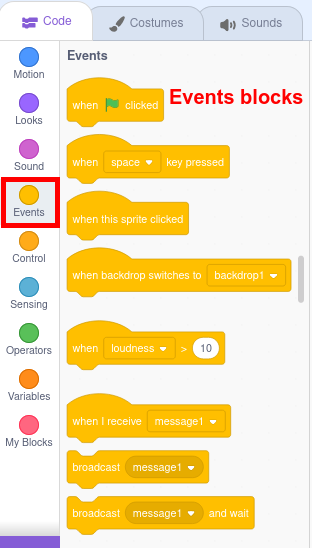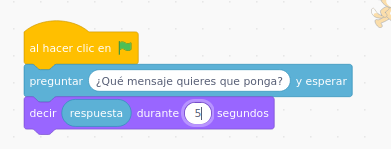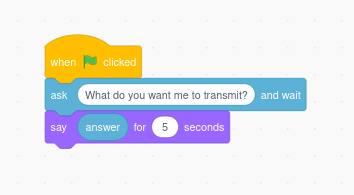Input
UnA programaprogram comolike elthe ejemploexample delof programathe HolaHello mundoWorld visto enis elnot apartadotypical anteriorin noprogramming. esIncreasingly, lowe habitualseek ento programación.create Cadaprograms vezthat más,carry buscamosout realizaractions programasthat queare realicennot accionesmerely nopre-programmed meramenteand preprogramadasautomated, ybut automatizadas,rather sinoreact quebased reaccionenon enparameters funciónprovided deby unosthe parámetrosuser. suministradosAll pordata lathat personais usuaria.provided Todosto aquellosthe datosprogram queexternally sefor lesubsequent proporcionanprocessing alis programawhat dewe forma externa para su posterior procesamiento es lo que llamamoscall ENTRADASINPUTS.
LasInputs entradascan puedenbe sersupplied suministradasin detwo dos formas:ways:
De formamanualManually:setheylearesolicitanrequestedafromlathepersonauserusuariaandytheyestaenterlosthem,introduce,normallynormalmenteviavíamouseratónorokeyboard.teclado.DeInformaanautomatizadaautomated:medianteway:sensoresthroughquesensorsfacilitanthatdichaprovideinformacióndelinformationentorno.aboutPorthesupuestoenvironment.conOf course with PSeIntnowepodemoscan'thacerdoesto,this,perobutconwith Scratchsí.we can.
ParaTo entenderbetter mejorunderstand elthe conceptoconcept deof EntradaInput, realizaremoswe unawill variante del programa Hola mundo que llamaremos Transmito tu mensaje en el que el programa solicitará de la persona usuaria el mensaje que quiere transmitir, ycreate a continuaciónvariant loof mostraráthe enHello pantalla.World Vayamosprogram pasothat awe paso:will call Transmitting your message in which the program will request from the user the message they want to transmit, and then display it on the screen. Let's go step by step:
PasosSteps 1 yand 2: AnálisisAnalysis yand diagramaflow dechart flujoof del programathe TransmitoTransmitting tuyour mensajemessage program
.Let's Veamosfirst enlook primerat lugarthe losnecessary elementoselements necesariosin entihis dichoprogram programaand yits su diagrama de flujo:flowchart:
InicioStartyandfinendde programa.SalidaOutput:SeAnecesitafirstunaoutputprimeraissalidaneededpreguntandoaskingporforelthecontenidocontentdelofmensajetheymessageunaandsegundaamostrándolo.second showing it.EntradaInput:elthecontenidocontentdelofmensaje.the message.EnInestethisprogramaprogramapareceaunnewnuevoconceptconceptoappears,quewhichesiselthatdeof a variable,esthatdecir un "contenedor" que almacena los datos que recibe de la entrada, para su posterior procesamiento. Lo veremos con más detalle en el siguiente apartado dedicadois, aalmacenamiento"container"dethatdatos.stores the data it receives from the input, for later processing. We will see it in more detail in the following section dedicated to data storage.
ElThe diagramaflowchart de flujo sería:is:
PasosSteps 3, 4 y 5: Codificación,Coding, compilacióncompilation yand verificaciónchecking delof programathe Transmitting your message program Transmito tu mensaje conwith PSeInt
PartiremosWe dewill nuestrostart ficherofrom Hola_mundo.psc,our leHello_world.psc cambiaremosfile, elwe nombrewill alchange algoritmothe yname alof fichero,the yalgorithm enand estethe casofile, introduciremosand unain vezthis máscase elwe comandowill enter the Escribir puestocommand queonce necesitamosagain dossince salidas.we need two outputs.
ParaTo recibirreceive entradasinputs enin PSeIntPSeInt, se utiliza el comandothe Leer seguidocommand deis laused followed by the variable enin lawhich quethe sereceived almacenarácontent elwill contenidobe recibido.stored. NosotrosWe lewill llamaremossimply simplementecall it mensajemessage.
PSeInt nosmakes facilitait eleasier nofor tenerus queto definirnot elhave tipoto dedefine contenidothe atype recibirof previamentecontent to receive previously (textual, numérico.numerical...) sinobut querather seit adaptaadapts to the response, in this case a lastring respuesta,of en este caso una cadena de caracteres.characters.
ParaTo comprobarcheck suhow funcionamiento,it haremosworks, clicwe enwill elclick botónon the Ejecutar debutton laon barrathe detoolbar herramientasand yverify comprobaremosthat queit realizaworks loas esperado.expected.
PasosSteps 3, 4 y 5: Codificación,Coding, compilacióncompilation yand verificaciónchecking delof programathe Transmitting program Transmito tu mensaje conwith Scratch
EnIn ScratchScratch, partepart deof losthe bloquesblocks relacionadosrelated conto ladata entradainput deinto datosthe enprogram elare programafound sein encuentran en el menúthe SENSORESSENSING menu (light blue) We also provide inputs with the EVENTS menu (yellow), ywith tienenblocks colorto azulindicate claro.what Tambiénexternal proporcionamosaction entradaswill condetermine elwhether menúthe EVENTOS,program conis bloquesexecuted paraone indicarway quéor acción exterior determinará el que el programa se ejecute de una forma u otra.
another.
ComoSENSING veíamosincludes antes,both enblocks SENSORESto seask incluyenand tantoreceive bloquesdirect paraanswers preguntarfrom yusers, recibiras respuestaswell directasas deother lastypes personasof usuarias,input comorelated otroto tipotouching de entradas relacionadas con estar tocando algosomething (otrosother objetos,objects, colores)colors), estarbeing at a determinadacertain distancia,distance, alcanzarreaching una volumensound devolume, sonido,finding encontrarseoneself enin unaa zonacertain determinadaarea delof lienzo,the pulsarcanvas, unapressing teclaa okey elor ratón,the mouse, etc...
SiIf quisiéramoswe programarwant algoto program something similar alto programathe anteriorprevious tendríamosprogram quewe utilizarwould loshave siguientesto bloques:use the following blocks:
Scratch almacenastores lowhat introducidois porentered tecladoby enkeyboard unain a predefined variable predefinida llamadacalled respuesta,answer, available in the same sensingdisponible enmenu. elVariables mismoand bloqueother dedata sensores.storage Precisamentestructures lasare variablesthe yobjective otrasof estructurasthe denext almacenamiento de datos son el objetivo del siguiente punto.
point.
{{@5685}}

